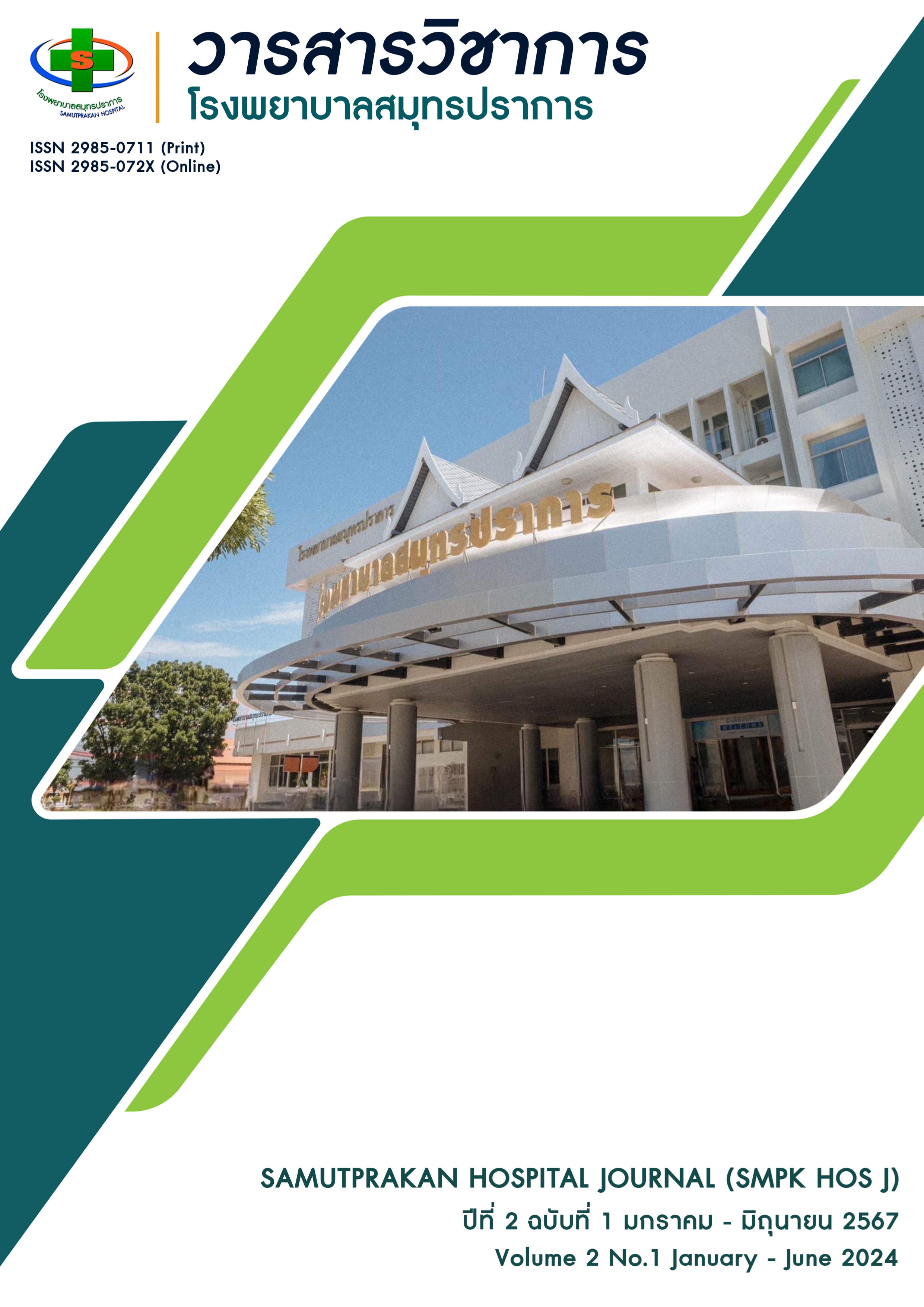Results of using guidelines after cataract surgery via line official in the Eye, Ear, Nose, and Throat Department, Samutprakan Hospital
Keywords:
cataract surgery, Line Official Account, knowledge, practicesAbstract
This experimental research uses a one-group pretest-posttest design to evaluate the impact of Line Official Account guidelines on knowledge and practices related to post-cataract surgery care. The sample group, selected through purposive sampling, consisted of 30 cataract patients who underwent surgery at the Eye, Ear, Nose, and Throat Department of Samutprakan Hospital.
The research tool was a questionnaire that included sections on personal information, a knowledge test about cataracts, a measure of patient behavior after cataract surgery, and a measure of satisfaction with the guidelines provided via the Line Official Account. The questionnaire's accuracy was verified by experts, and its reliability was tested using Cronbach's alpha method. The reliability values were as follows: 0.654 for the cataract knowledge measure, 0.705 for the patient behavior after cataract surgery measure, and 0.668 for the satisfaction measure with the post-cataract surgery guidelines via Line Official.
Data were analyzed using descriptive statistics, including number, percentage, mean, and standard deviation, as well as inferential statistics, specifically the paired t-test.
The study found that the sample group exhibited significantly higher knowledge after using the post-cataract surgery guidelines via Line Official, with a statistical significance (p<0.01). Additionally, patient behavior after using the guidelines was significantly better than before (p<0.01). Overall satisfaction with the post-cataract surgery guidelines via Line Official was high, with a mean satisfaction score of 3.65.
References
วริศรา อินทรแสน, วรรณวีร์ บุญคุ้ม, คณิต เขียววิชัย. การศึกษาสภาพการณ์ปัจจุบันของผู้สูงอายุด้าน ความสุขในยุคไทยแลนด์ 4.0 ในกลุ่มจังหวัดภาคกลางปริมณฑล. วารสารศรีนครินทรวิโรฒวิจัยและพัฒนา (สาขามนุษยศาสตร์และสังคมศาสตร์). 2020;12(24):78-90.
ลักษณาพร กรุงไกรเพชร. ต้อกระจกในผู้ป่วยเบาหวาน. บูรพาเวชสาร. 2561;5(1):95-103.
คณะกรรมการส่งเสริมประสานงานผู้สูงอายุแห่งชาติสำนักนายกรัฐมนตรี. แผนพัฒนาผู้สูงอายุแห่งชาติฉบับที่ 2 (พ.ศ. 2545-2564). กรุงเทพฯ: สำนักนายกรัฐมนตรี; 2545.
อาภัทร สาเล็กสกุล. จักษุวิทยา รามาธิบดี. กรุงเทพฯ: คณะแพทย์ศาสตร์โรงพยาบาล รามาธิบดี มหาวิทยาลัยมหิดล; 2561.
อังคนา อัศวบุญญาเดช, ดุจดาว ศุภจิตกุลชัย, วริศนันท์ ปุรณะวิทย. ผลการสอนสุขศึกษาโดยใช้สื่อวีดีทัศน์เรื่องการปฏิบัติตัวหลังทำผ่าตัดต้อกระจกให้กับผู้ป่วยผ่าตัดต้อกระจก. บูรพาเวชสาร. 2565;9(1):67-89
โรงพยาบาลสมุทรปราการ. รายงานแบบประเมินตนเอง ปี 2566.
กนกพร อริยภูวงศ์, ศุภพร ไพรอุดม, ทานตะวัน สลีวงศ์. ผลของการพยาบาลระบบสนับสนุนและให้ความรู้ต่อพฤติกรรม การดูแลตนเองของผู้ป่วยผ่าตัดต้อกระจกโรงพยาบาลสุโขทัย. วารสารวิทยาลัยพยาบาลพระจอมเกล้า จังหวัดเพชรบุรี. 2019;2(3):17-30.
Bloom BS. Taxonomy of Education Objectives: The classification of education goal. New York: Longman; 1986.
Best JW. Research in education. Englewood Cilifts. New Jersy: Printice-Hall; 1970.
เฉลิมศักดิ์ บุญประเสริฐ, กัลยา ใจรักษ์. ปัจจัยที่มีอิทธิพลต่อการยอมรับการใช้แอปพลิเคชั่นไลน์ของผู้สูงอายุ (Doctoral dissertation). บัณฑิตวิทยาลัย มหาวิทยาลัยราชภัฏเชียงใหม่; 2563.
Downloads
Published
How to Cite
Issue
Section
License
Copyright (c) 2024 Samutprakan Hospital Journal (SMPK HOS J)

This work is licensed under a Creative Commons Attribution-NonCommercial-NoDerivatives 4.0 International License.







